Timothy Riesterer's Blog, page 10
November 7, 2018
Three Counter-intuitive Ideas for 2019 Sales Kickoff Meetings
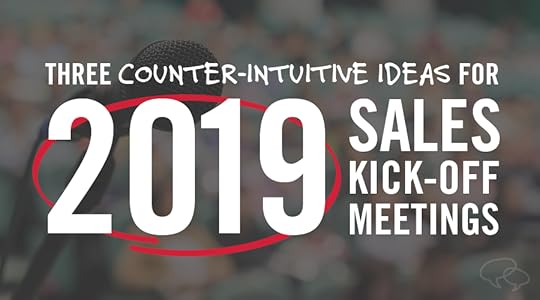
Want to wow your sales team for kickoff? Try some new approaches that could help reps have value conversations customers want to have.
Tis the season for picking sales meeting kickoff themes for sales and marketing organizations around the world. You definitely have to set the dates, confirm the budget, find the location, and get executive buy-in. But when it comes to the content for the sales kickoff meeting, don’t settle for a new version of the same checklist you may be using.
Here are three counterintuitive ideas to help your salespeople really remember and use your content from your 2019 sales kickoff.
1. Model conversations vs. new sales pitches
Sales kickoffs are usually full of new products and updated features. And that’s okay. But instead of hours of feature-dense presentations that focus all on you, what if you modeled great customer conversations?
76% of buyers will buy from a company that illustrates a buying vision—rather than another entry in a long list of commodity suppliers. Show your sales reps how to lead to your offerings by creating the urgency for customers to make a change in the way they’re solving for future challenges. Then you can position your offerings in a unique and impactful way. (Also read It Takes More Than a Technology Stack to Drive Demand)
2. Enable conversation competencies vs. sales processes
Many companies are making great inroads in new training methodologies and technologies, but how much time will you dedicate to training skills and processes that mostly feature how your salespeople should manage a sale cycle when most people agree the customer has the most power?
71% of sales managers agree the ability to “articulate value” is the biggest difference between high and low sales performers. So what if you enabled your team’s competencies to progress opportunities based on having conversations that customers truly find valuable? What if they could create pipeline based on establishing differentiation, write proposals that pass executive muster, and close opportunities profitably without losing value throughout the sale cycle? That would make for a big kickoff! (Also read Are Your Reps a Selling “Triple Threat?”)
3. Advise brain science vs. new theories
Hey, I love a good book, too. And sometimes CEOs fall in love with a new business book that offers to introduce best practices into your sales training. But often companies just imitate the processes of other companies with mixed successes. The challenge is that “best practices” are other people’s successes, which means it’s old news, and your competitors read the same books. So at best you’re frustrating your team and at worst your enabling mediocrity.
But what if you didn’t follow the crowd to this year’s book club favorite theory, and instead introduced skills that leverage how the human brain perceives value, and how buyers make decisions based on how it perceives value? Understanding how customers buy, vs. how OTHER salespeople sell, would make a much greater impact at a sales kickoff! (Also read Best Practices Aren’t Always the Best Methods over at td.org)
You only get a few days with your whole sales team in one place. Try one of these counterintuitive ideas! And I’d be interested in your plans for your 2019 kickoff meetings!
The post Three Counter-intuitive Ideas for 2019 Sales Kickoff Meetings appeared first on Corporate Visions.
November 5, 2018
Seven Tips for More Effective Sales in 2019
The post Seven Tips for More Effective Sales in 2019 by Corporate Visions appeared first on Corporate Visions.

You always want to ensure that your business is getting the most from your sales resources. But in today’s economy, maximizing sales effectiveness is critical – and could make the difference between struggling for survival and generating growth.
Here are seven of our sales tips and tricks to help you drive more effectiveness out of your team in 2019 and beyond.
Our Top 7 Sales Tips And Tricks To Drive More Effective Results
1. Develop a distinct point of view
A unique point of view is a deliberate approach to changing your customer conversations in a way that puts you in the position of sharing useful insights. It helps your customer see around the corner at what challenges are headed his way and provides him with a way out.
How it creates more effective sales: Having a distinct point of view moves you out and to left of the bake-off and puts you in a position of guiding the customer buying cycle.
2. Create a context that makes your prospects care.
Too many salespeople want to lead with the strengths of their product or service.
The problem is that the customer isn’t ready to hear about them. They have no frame of reference to put those strengths of yours into a situation that they feel is uniquely theirs.

How it creates more effective sales: You need to establish the right context to create urgency. It’s not your product that makes the customer care. It’s the changing context that makes it meaningful and gets the customer to consider doing something different.
3. Target the status quo, not the persona.
If you are like many marketers today, you have created personas with demographics, attitudes, and behaviors to help frame and target your messages.
But demographics and attitudes have little to do with what motivates real prospects; you need to challenge the status quo so as to motivate them.
How it creates more effective sales: If prospects believe their status quo is at risk and they may need to do something different than they are doing today, they will be more receptive to your message.
4. Align sales content with the sales process.
The sales content that you provide your salespeople must not only match the messaging. This content must also align with actual selling tasks performed throughout the sales process.
These activities include emails, phone calls, face-to-face conversations, team presentations, and other communications.
How it creates more effective sales: Your sales reps are more likely to use sales content if you provide it in the form factor in which they and your prospects want to consume your messages.
5. Use grabbers.
Before your prospects are ready – and willing – to listen to your message, you need to capture their attention. Get them curious, have them thinking, “What next?”
Use grabbers – the “wow” of your message – to create your hot opening, hot closes, and spikes in the middle of your message.
How it creates more effective sales: Grabbers get your prospects emotionally involved, literally and figuratively leaning into your message. They’ll become more openly receptive, not just passively listening to your messaging.
6. Use visual storytelling.
The white paper is a staple of the B2B sales toolkit. But of the five senses, the Old Brain responds most strongly to visual stimuli.
This is the part of your brain that acts as a filter and decides what gets noticed. You need to transform your traditional written word messages into visual vignettes.

How it creates more effective sales: By replacing your white papers and other written documents with visual materials that stimulate the Old Brain, you make it easy for your prospect to see how your solution affects their world.
7. Have conversations, not presentations.
Turn off the projector and turn on the lights. Instead of giving a run-of-the-mill PowerPoint presentation, grab a marker and an easel pad and have a conversation with your prospects.
How it creates more effective sales: By translating your biggest ideas into a few easy-to-remember numbers and simple visuals. One of the keys is to communicate via an interactive dialogue rather than a one-way lecture. By doing so, you’ll get your prospects engaged, even after you’ve left the room.
At Corporate Visions, we’ve crafted a portfolio of solutions designed to help you achieve more effective sales.
Want to put these seven sales tips and tricks into practice?
We can help you implement these techniques, empowering you and your sales teams accomplish so much more.
Thank you for reading this post from Corporate Visions - Differentiate Your Marketing Messages and Sales Conversations.
Seven Tips for More Effective Sales
The post Seven Tips for More Effective Sales by Corporate Visions appeared first on Corporate Visions.

You always want to ensure that your business is getting the most from your sales resources. But in today’s economy, maximizing sales effectiveness is critical – and could make the difference between struggling for survival and generating growth. Here are seven sales tips to help you drive more effectiveness out of your team.
Our Top 7 Sales Tips And Tricks To Drive More Effective Results
1. Develop a distinct point of view
A distinct point of view is a deliberate approach to changing your customer conversations in a way that puts you in the position of sharing useful insights. It helps your customer see around the corner at what challenges are headed his way and provides him with a way out.
How it creates more effective sales: Having a distinct point of view moves you out and to left of the bake-off and puts you in a position of guiding the customer buying cycle.
2. Create a context that makes your prospects care.
Too many salespeople want to lead with the strengths of their product or service. The problem is that the customer isn’t ready to hear about them. She has no frame of reference to put those strengths of yours into a situation that she feels is uniquely hers.
How it creates more effective sales: You need to establish the right context to create urgency. It’s not your product that makes the customer care. It’s the changing context that makes it meaningful and gets the customer to consider doing something different.
3. Target the status quo, not the persona.
If you are like many marketers today, you have created personas with demographics, attitudes, and behaviors to help frame and target your messages. But demographics and attitudes have little to do with what motivates real prospects – and to motivate them, you need to challenge the status quo.
How it creates more effective sales: If prospects believe their status quo is at risk and they may need to do something different than they are doing today, they will be more receptive to your message.
4. Align sales content with the sales process.
The sales content that you provide your salespeople must not only match the messaging, it must also align with actual selling tasks performed throughout the sales process. These activities include emails, phone calls, face-to-face conversations, team presentations, and other communications.
How it creates more effective sales: Your sales reps are more likely to use sales content if you provide it in the form factor in which they – and your prospects – want to consume your messages.
5. Use grabbers.
Before your prospects are ready – and willing – to listen to your message, you need to capture their attention, get them curious, and have them thinking, “What next?” Use grabbers – the “wow” of your message – to create your hot opening, hot closes, and spikes in the middle of your message.
How it creates more effective sales: Grabbers get your prospects emotionally involved, literally and figuratively leaning into your message, making them openly receptive, not just passively listening to it.
6. Use visual storytelling.
The white paper is a staple of the B2B sales toolkit. But of the five senses, the Old Brain – that part of your brain that acts as a filter and decides what gets noticed – responds most strongly to the visual sense. You need to transform your traditional written word messages into visual vignettes.
How it creates more effective sales: By replacing your white papers and other written documents with visual materials that stimulate the Old Brain, you make it easy for your prospect to see how your solution affects his world.
7. Have conversations, not presentations.
Turn off the projector and turn on the lights. Instead of giving a run-of-the-mill PowerPoint presentation, grab a marker and an easel pad and have a conversation with your prospects.
How it creates more effective sales: By translating your biggest ideas into a few easy-to-remember numbers and simple visuals – and communicating them via an interactive dialogue rather than a one-way lecture – you’ll get your prospects engaged, even after you’ve left the room.
At Corporate Visions, we’ve crafted a portfolio of solutions designed to help you achieve more effective sales, and we can help you implement these seven tips – and many more.
Thank you for reading this post from Corporate Visions - Differentiate Your Marketing Messages and Sales Conversations.
October 13, 2018
2019 Sales Kickoff Meeting Themes: Three Profitability “Moments of Truth”
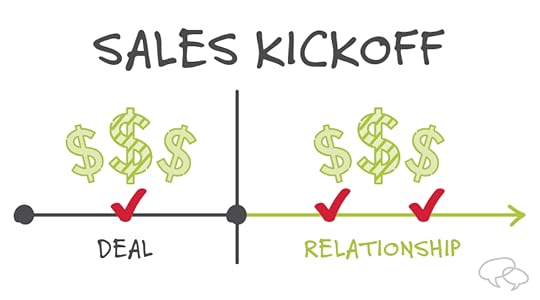
Make your 2019 sales meeting kickoff theme about maximizing profitability throughout the entire customer relationship, not just during the initial deal
Filling the funnel, driving pipeline, and acquiring net-new customers will always be the sexy, swashbuckling side of B2B sales—which is why so many sales meetings are overwhelmingly focused on preparing salespeople for success in exactly this stage of the buying cycle. Similarly, when it comes to maximizing profitability, so much sales preparation is skewed toward opportunities to drive profitability during the deal cycle—rather than on all the opportunities reps have to drive profitable growth throughout the life of their accounts.
For your 2019 sales kickoff meeting, it’s time to think deeper about how you can prepare reps to capture more value both during the deal stage and after it when your prospects become customers and you need to expand the value of your relationship. With that in mind, I’m going to look at one key moment you need to train for during the deal, and two key moments your reps need to master with customers that are already in the fold.
The 3 Moments Of Truth To Address At Your 2019 Sales Kickoff Meeting
1. Create Pricing Uncertainty During the Deal
McKinsey & Company found that a one percent increase in pricing equates to a nine percent increase in operating margin. When it comes to maximizing profitability during the deal, this finding underscores how crucial it is to employ specific messaging techniques that allow you to expand the scope and size of your discussions. For salespeople in negotiations, that means introducing unconsidered needs—i.e. problems or missed opportunities your prospects haven’t yet considered—to create pricing uncertainty, which de-commoditizes your solutions while expanding the value of—and need for—your offerings. When it comes to capturing more value, this is a far more effective way to protect your pricing and close profitable deals than resorting to traditional late-game negotiation tactics.
2. “Why Stay?” – Tell the Right Story for Securing Renewals
If last year’s sales kickoff was all about training your salespeople to challenge and provoke your customers, you were preparing them adequately for acquiring new customers. As for keeping current ones? Not so much. Corporate Visions research shows that applying the same provocative messaging approach that works so well with prospects will actually backfire when it comes to existing customers you’re trying to renew. Despite this, a Corporate Visions industry survey found that nearly 60 percent of companies don’t feel the need to tell a different story for new customer acquisition versus customer retention/expansion.
That’s not good for your growth plans, according to an interesting stat cited in a Harvard Business Review article. The stat asserts that acquiring a new customer is anywhere between five to 25 times more expensive than keeping an existing one. That’s not so surprising when you consider that high startup and support costs can mean customers have to be an active account for months, maybe years before they become fully profitable. Given the findings from our own research, the renewal story isn’t something companies should just wing. Nor is it a message that should in any way resemble the story you tell to acquire new customers.
3. “Why Pay?” – Communicate Price Increases Effectively
Renewals aren’t a conversation you want to take lightly from a structure and strategy standpoint, and the same goes for price increases, which are notoriously tricky and delicate. Unfortunately, many companies are in fact skimping on the messaging rigor in this moment: a Corporate Visions industry survey found that four out of five say they want more direction and guidance around communicating price increases (or the “why pay” story).
Like the renewal conversation, your price increase discussions demand the kind of messaging that’s fundamentally different—even opposite—from the sort of story you tell when prospecting (you can learn about the tested and proven “why pay” messaging framework here). As a result, salespeople need to be trained to understand the unique buyer psychology germane to this critical moment.
What sales kickoff isn’t about maximizing profitability? That’s ultimately why you’re making big investments to bring your sales team together this year. But in 2019, don’t restrict your focus just to early-stage demand generation and pipeline creation—especially at a time when more companies are moving to a products-as-a-service experience, an evolution that’s shifting the pressures and opportunities to other key moments beyond the initial transaction. So, when you talk about capturing value and maximizing profitability at your corporate sales meeting this year, remember that you’re talking about much more than just deal-stage pricing negotiations.
Want to learn more about structuring your next kick-off to better prepare your reps to sell better across the variety of scenarios they face? Check out our eBook: Putting Your Sales Kick-off In Context
Filling the funnel, driving pipeline, and acquiring net-new customers will always be the sexy, swashbuckling side of B2B sales—which is why so many sales meetings are overwhelmingly focused on preparing salespeople for success in exactly this stage of the buying cycle. Similarly, when it comes to maximizing profitability, so much sales preparation is skewed toward opportunities to drive profitability during the deal cycle—rather than on all the opportunities reps have to drive profitable growth throughout the life of their accounts.
For your 2019 sales kickoff meeting, it’s time to think deeper about how you can prepare reps to capture more value both during the deal stage and after it when your prospects become customers and you need to expand the value of your relationship. With that in mind, I’m going to look at one key moment you need to train for during the deal, and two key moments your reps need to master with customers that are already in the fold.
The 3 Moments Of Truth To Address At Your 2019 Sales Kickoff Meeting1. Create Pricing Uncertainty During the DealMcKinsey & Company found that a one percent increase in pricing equates to a nine percent increase in operating margin. When it comes to maximizing profitability during the deal, this finding underscores how crucial it is to employ specific messaging techniques that allow you to expand the scope and size of your discussions. For salespeople in negotiations, that means introducing unconsidered needs—i.e. problems or missed opportunities your prospects haven’t yet considered—to create pricing uncertainty, which de-commoditizes your solutions while expanding the value of—and need for—your offerings. When it comes to capturing more value, this is a far more effective way to protect your pricing and close profitable deals than resorting to traditional late-game negotiation tactics.
2. “Why Stay?” – Tell the Right Story for Securing RenewalsIf last year’s sales kickoff was all about training your salespeople to challenge and provoke your customers, you were preparing them adequately for acquiring new customers. As for keeping current ones? Not so much. Corporate Visions
The post 2019 Sales Kickoff Meeting Themes: Three Profitability “Moments of Truth” appeared first on Corporate Visions.
October 8, 2018
Your Virtual Edge

5.7 million. That’s how many sales professionals are currently in the U.S., according to a market-sizing survey done by InsideSales.com. Just over 47% of these salespeople are inside sales reps, while just under 53% are outside.
So, what’s the average sales call look like? Well, Inside salespeople have the word “inside” in their title, so of course all of their meetings with prospects and customers are remote. But even the “outside” sales reps of today are no strangers to “virtual” calls, as they spend more than 45% of their time selling remotely, an 89% increase from 2013, the last time InsideSales.com ran the survey.
For the non-math majors, that means that 75% of all sales meetings are now handled remotely. This shows you just how widespread virtual meetings, conducted by phone or web conference, have become.
Ok, virtual sales meetings are a big deal. The reality is this is a tough selling forum in which you must outperform your competition if you hope to gain traction today. Which begs the question: how effectively are salespeople actually handling these meetings today?
A Disconnect Between Belief and Action?
Given how integral remote calls have become to the sales workflow, it’s not surprising to find an appetite for improvement in this area. More than half of respondents to a Corporate Visions industry survey say optimizing messaging and content assets for the virtual selling environment is “extremely important.”
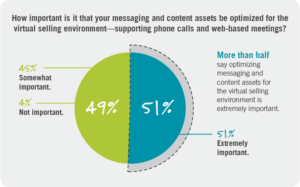
And, half of survey respondents think they do a good job tailoring their messages for these environments.
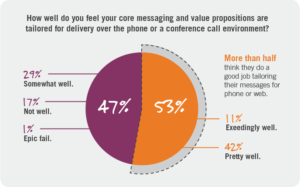
I’m loving the confidence. So more than half think it’s important and even more think they’re doing well. But is this confidence misplaced? It’s worth asking, because there’s evidence suggesting that many sellers aren’t using the approach they think will have the most positive impact on performance.
Let’s take interactive visual storytelling. In a virtual setting, 64% of sales professionals believe using interactive storytelling techniques would make a material, positive difference. And in this same study, the highest number of respondents rate it as the most effective approach for telling their story and moving prospects and customers to action. So, there must be a ton of people using such a powerful technique, right? Nope. Currently only 12% of respondents use interactive visual storytelling techniques in their virtual meetings.
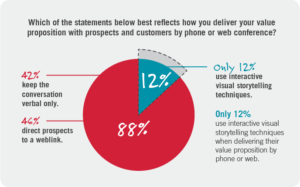
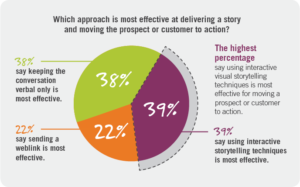
What’s incredible about this data is it means that 27% believe they are using an ineffective sales approach, but just keep doing it.
So here’s the lay of the land, in summary:
-Most say tailoring for virtual is extremely important
-Most think they do a pretty good job of it
-Very few use interactive visual approaches
-Even though the highest percentage believe it’s most effective and the majority think it would make a material difference in the success of their meetings
There’s no shortage of thoughts and opinions on how to be most compelling in these meeting environments. But those, after all, are just thoughts and opinions. What does the research actually say?
The Test Simulation
We put a range of meeting approaches to the test in a research simulation with Dr. Nick Lee, a professor at the Warwick Business School in Coventry, U.K. For the study, we specifically wanted to test the effect of the different call approaches on attitude and recall, since there is a premium on being compelling and memorable in virtual sales meetings.
Conducted online, the simulation involved 800 participants who were randomly divided into four different test conditions—some more participatory and interactive than others. At a basic level, the conditions can be summarized as: 1) Listen Only; 2) Listen and Watch Only; 3) Listen, Watch and Take Notes; 4) Listen and Draw as Directed.
All participants were instructed to imagine themselves as executives at a food processing company who were hearing pitches from vendors who wanted to help them make the shift from large-batch to small-batch production to capitalize on growing demand for organic foods. Making that shift successfully requires more flexible processing techniques, as well as lower labor and materials costs.
The intent of the message in all conditions was to set up a face-to-face meeting with the participants and their fellow executives to discuss the purchase of an organic processing system to help them execute the strategy described above.
The message in each condition followed the Why Change story model—a message framework designed to break through status quo bias, create urgency, and make a compelling case for change. While the message was conveyed in different ways across the conditions, the substance of the message was the same in all of them.
For participants not in the Listen Only condition, the story that developed relied on simple, concrete images that emphasized the decline of large batch processing and the growth potential and upside of small batch processing. Per the visual below, which was used in the three participatory conditions, negative factors such as higher costs and excessive changes were drawn in red, while positive outcomes associated with the organic processing system, such as increased market share, revenues, and profit margin, were rendered in blue.
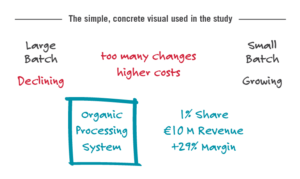
After experiencing the respective conditions, participants answered a series of numerically valued questions that were then combined to create a composite index for each assessed area. Lower numbers corresponded to less impact in a given area, while higher numbers corresponded to more positive effects.
The first area we wanted under focus was attitude and disposition measures, to measure the effect on critical measures such as uniqueness, how unusual or unexpected the call was, how compelling the call was, and how likely it was to produce a meeting. Across these areas, the Listen and Draw approach consistently performed the best. In each chart you will see a calculation showing by what percentage the other conditions under-performed the winning condition.
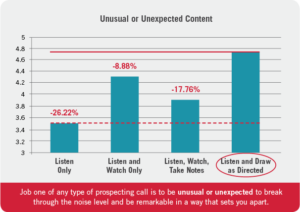
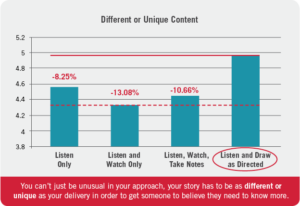
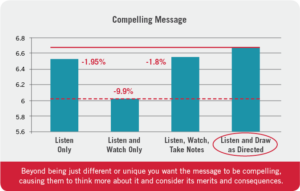
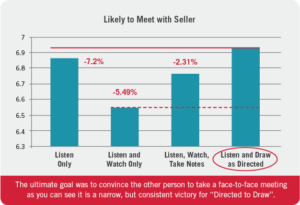
Most importantly, the Listen and Draw approach had the best aggregate score, by far, when you combined all attitudinal measures assessed in the simulation. Interestingly, the Listen Only condition holds its own against the others and significantly outperforms “Listen and Watch”—which generally performed poorly.
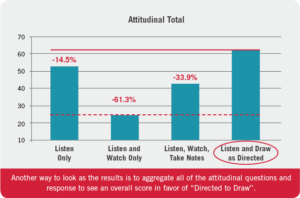
The study also assessed the recall and retell-ability of the various conditions—both key indicators of how remarkable and memorable the call was. In this case, the Listen, Watch, and Take Notes condition was a convincing winner across areas like confidence in recall, number of correct recalls, confidence in getting colleagues interested in a meeting, and confidence in retelling the story to colleagues. Meanwhile, the Listen Only conditions sinks to last place in all recall and retell-related questions.
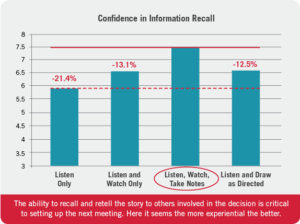
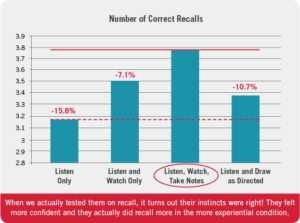
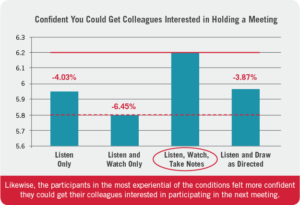
Interestingly, in the simulation, you see essentially the same curve between the confidence in recall and the actual recall, with the Listen Only condition lagging far behind in both areas.

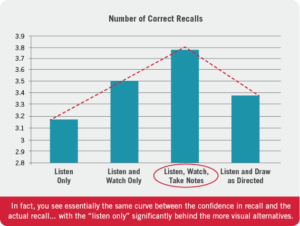
The big takeaway here: visual stories are vital to engaging your audience, increasing favorable attitudes toward you, and improving the ability of your prospects and customers to remember you after your meeting is through. Basically, the more participatory your approach, the more memorable and compelling you will be. This research is a mandate for you to get beyond passive when meeting with your prospects remotely, and to shun the less participatory and interactive approaches that reduce positive attitudes toward your message and make you less remarkable. Conventional wisdom might have held that “reducing” by keeping the call focused on the verbal conversation only was key to conducting productive meetings in a remote environment. But the research doesn’t bear that out. Rather, it shows that the less experiential the approach, the less positive impact you will have in the areas of greatest importance.
Salespeople have a huge opportunity to gain an edge in these crucially important selling environments. A Corporate Visions survey shows that 87% of salespeople don’t engage prospects or customs with visual storytelling techniques.
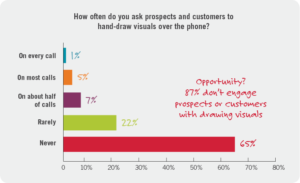
Sellers know they should be having these types of conversations. They know it would be more effective and the data confirms it. So, what’s your excuse? Sales is all about increasing your probability of winning. This is your chance to leap frog the competition and give yourself a competitive edge. There’s a lot of upside for you to become more memorable and differentiated in the virtual meeting environments you increasingly find yourselves in. The question is, are you ready to leverage your virtual edge?
The post Your Virtual Edge appeared first on Corporate Visions.
October 4, 2018
Four Selling Moments You Need to Master
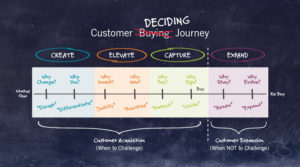
When you really boil it down, your success as a sales organization comes down to how effective you are at acquiring new customers and expanding with existing ones. But, you’re mistaken if you think you can apply the same messaging and selling competencies to one effort as you would to the other. Research proves that customer acquisition and customer expansion are shaped by significantly different buying pressures. As such, the buyer psychology of new customers is nearly the opposite of the buyer psychology of existing ones.
To be great at convincing customers to buy (and buy again and again), there are four distinct moments you need to master in the customer deciding journey—which is really about engaging prospects and customers effectively in the series of key decisions they need to make to succeed. The messaging and skills training required for these moments varies based on whether you’re trying to defeat the status quo (acquire new customers) or reinforce the status quo (keep existing ones).
When you’re on the outside and trying to acquire new customers, you need to be able to:
Create Value – Disrupt status quo bias and differentiate your solutions
Elevate Value – Build a more effective business case that justifies executive decisions
Capture Value – Maximize the profitability of each deal
When you’re the incumbent, you need to be able to:
Expand Value – Renew and expand existing customer revenue
Let’s start when you’re the outsider and you need to overcome status quo bias—convincing prospects not just to make a change, but to do it with you, not your competitors.
Create Value
Sales is more about change management than it is about selling. That’s because 60% of qualified opportunities end in “no decision.” As the outsider, you are fighting inertia—or status quo bias. To vanquish this force, you need to disrupt its causes, drive the need for change, and create a buying vision that favors you over your competition. That requires articulating compelling answers for two pivotal questions your prospects are asking: Why Change (why should I do something different?) and Why You (why should I do it with you?).
Elevate Value
What about when you need to justify the value of your solution or service to busy executive decision makers? Why should they learn more about your solution (Why Invest), and why should they buy into your story and business case—and purchase now (Why Now).
Capture Value
As deals advance, it becomes harder to handle pricing pressures and avoid unnecessary discounting. Salespeople need the training to deal with that pressure and close deals profitably. In complex selling scenarios, they also need to learn techniques for guiding conversations through multi-party decision processes and avoiding any “last mile” challenges to reaching agreement.
The skills highlighted above address the sales inflection points when you need to defeat the status quo and acquire new customers. But what about when you are the status quo? That involves a drastically different buyer psychology and a dedicated message development and skills training approach—research proves it. When you need to retain customers (Why Stay) and expand with them (Why Evolve), you need a tailored strategy that meets to the demands of these moments. (Stay tuned for the soon-to-drop Expand Value Skills video, which takes a closer look at how to respond to the pressures of the critical customer retention/expansions scenarios).
One-size-fits-all approaches to your messaging and skills training won’t hold up across the range of decisions you need to influence. Today, great selling requires breaking free from universal approaches to the customer conversation and getting your customer acquisition and expansion strategies on the right side of the research.
Learn more here about what it takes to get there.
The post Four Selling Moments You Need to Master appeared first on Corporate Visions.
September 21, 2018
The Fourth Value Conversation
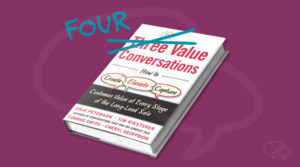
Or, When and Why to Break the Rule of Threes
There’s something so clean, clear, and economical about grouping things in threes. See? I just did it there. A trio of something, whether adjectives or bullet points, seems like the perfect amount of information—thorough enough to have substance, digestible enough to recall. In fact, for these reasons, the “Rule of Threes” is a speechwriting technique that many great orators have learned and mastered. Now, whether you need to place a comma before the third item may be up for debate. But the rhetorical power of the Rule of Threes is not.
But alas, sometimes even the most sacred rules are meant to be broken. That’s my rationale for the short story about I’m about to tell…
A few years ago, when a team of co-authors and I published The Three Value Conversations, we turned our focus (naturally) to three inflection points in the deal cycle that we thought—and still think—are fundamental to creating sales opportunities, bringing those opportunities through your pipeline, and negotiating a profitable close. The book was really about three moments of truth that occur in every deal cycle—three moments in which reps must:
-Create Value by breaking through status quo bias and creating differentiation
-Elevate Value by delivering bulletproof business proposals that meet executive standards
-Capture Value by driving consensus and negotiating effectively to close larger, more profitable deals
Together, the three value conversations spanned the entire customer acquisition side of marketing and sales. This side of the customer conversation demands provocation and disruptive insights. It demands edgy, swashbuckling messaging and skills designed to overcome status quo bias and break down your prospects’ aversion to change. After all, that’s what our research revealed to be the message that’s most effective when you’re the outsider and trying to displace an incumbent and convince a prospect to change and choose you.
But once you closed the deal, that’s kind of where it stopped. We assumed that what worked for new customer acquisition would translate to the key moments after the deal closed, when you need to retain and expand with existing customers. Nevertheless, we started hearing a certain question from some of our customers.
The Why Change/Why You story (and the research supporting it) is great for when you’re trying to defeat the status quo, they would say. But what about when you are the status quo? What about when you need to protect your accounts and even expand with them?
A series of studies—summarized here—with academic partners revealed that the key customer retention and expansion scenarios you need to succeed in have a dramatically different buyer psychology than that of new customer acquisition. They therefore demand different—and in some cases, diametrically opposite—messaging and skills approaches. Where you need to disrupt the causes of status quo bias as the outsider, you need to reinforce them when you’re on the inside.
Cumulatively, what the research reveals is that the customer conversation isn’t a one-size-fits-all proposition. Different moments require different messaging, and trying to apply the same messaging framework across every decision in the customer conversation will likely set you back. What became clear from the research is that mastery of all the buying situations of the customer lifecycle calls for a fourth value conversation that addresses customer retention and expansion and helps marketing, sales, and customer success teams apply a dedicated strategy and structure to these critical buying situations.
Enter “Expand Value,” for when you need to renew and expand existing customer revenue.
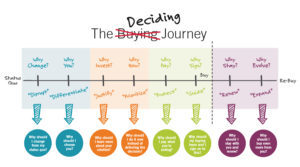
Customer success has emerged as a major growth engine—a separate messaging and selling discipline with its own unique pressures and demands. The key customer success scenarios you need to succeed in have a specific buyer psychology with specific messaging requirements and selling competencies. These scenarios include:
– Customer retention (Why Stay)
– Price increase communication (Why Pay More)
– Upsells and/or product migration (Why Evolve)
One thing is for sure: there is a huge opportunity to gain an edge in the areas above. A Corporate Visions industry survey found that nearly 60% of companies think they are fine applying the same provocation-based approach they use to acquire new customers as they do to expand business with existing ones. That flies in the face of the research, and it reflects precisely the one-size-fits-all mentality that Expand Value pushes back against. Because while research shows that challenging the customers works great with prospects, it also reveals that this approach will backfire with existing customers as you navigate the critical customer success and expansion situations.
I guess if you’re going to break a rule as compelling as the rule of threes, the decision should be guided by research rather than hunch. So with that said, here’s to letting the rigor of research—not the whimsy of feeling—dictate your response to the business challenges you face.
To dive deeper into how you can address your biggest customer retention and expansion challenges, check out this eBook: “Three Must-Win Moments in Customer Success Management”
The post The Fourth Value Conversation appeared first on Corporate Visions.
September 20, 2018
Research: Differentiating Your “Virtual” Sales Meetings
[image error]
What does the typical sales meeting look like today? A better question might be: What does the typical salesperson look like?
A market-sizing survey by InsideSales.com found that there are 5.7 million sales professionals in the U.S.—47% are inside sales reps, while about 53% are outside. Of course, inside sellers handle all their meetings remotely. But get this: today, outside reps spend 45% of their time selling remotely, an 89% increase from 2013.
That means 75% of all sales meetings are now remote. That’s how widespread meetings conducted by phone or web conference app have become today.
Clearly, this is a selling forum where you must outperform your competition if you hope to have success today. But how do you actually gain an edge? How do you become more compelling and memorable than the competitors you’re up against?
As you’ll see in this article from the International Journal of Sales Transformation, there’s no shortage of theories about what makes for a compelling sales call. Much conventional wisdom centers on “reducing friction” by keeping the conversation strictly verbal or simply directing prospects to a weblink with a Powerpoint. In fact, a survey by Corporate Visions and InsideSales.com found that only 12% of sellers use interactive visual storytelling techniques in remote meetings.
But more important than opinion and hunch is the research about what makes for a truly remarkable conversation in a remote meeting environment. That study, conducted in partnership with the International Journal of Sales Transformation and Dr. Nick Lee, a professor at the Warwick Business School, is covered in the article link below. Discover the selling skills and techniques you need to outperform your competition in the selling environments that matter most today.
Get the research article: The Next Best Thing to Being There
The post Research: Differentiating Your “Virtual” Sales Meetings appeared first on Corporate Visions.
September 17, 2018
Why Your Sales Kick-Off Needs a Shake-Up
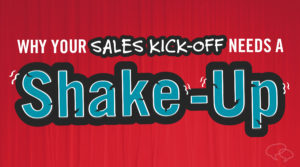
The sales kick-off needs to hit the reset button. Why? Because too many kick-offs get bogged down by product knowledge breakouts (information) while failing to deliver the very thing the event was supposed to inspire (behavior change, i.e. transformation). An over-reliance on product presentations hurts the kick-off format because these sessions often come at the expense of more customer-centric activities, including practice and coaching, that drive more energy and better performance out of the gates.
Re-imagining your kick-off event really comes down to answering this two-part question: How do you launch strategic growth initiatives, while also energizing your teams to change the necessary behaviors to activate those programs?
It starts with basing your kick-off not on product enablement, but on better customer conversation enablement. This is the actual engagement (story and skills) your sales teams need to master to move the buyer from status quo to interested to yes!
So, how does learning and practicing new stories and skills drive faster, better performance than product knowledge breakouts and persona training?
It starts with helping sellers understand the science of decision making and what excites sellers. It moves to demonstrating new stories based on the science of how buyers frame value and make choices. It then pivots to the new storytelling skills required to deliver these distinctive customer conversations. And it finishes with observable practice and coaching, along with follow-on activities for demonstrated proficiency—all designed to drive sustained impact in the field, long after your event concludes.
This eBook provides more detail for each of these steps, and gives you a better agenda for enabling a more transformative sales kick-off—before, during and after your event.
It’s time to make your sales kick-off was it was always meant to be—i.e. the ideal venue in which to initiate business transformation. Discover the fundamentals of planning, staging, and building on a transformative sales kick-off event—one that will energize your reps and propel high performance in the field long after it’s over.
The post Why Your Sales Kick-Off Needs a Shake-Up appeared first on Corporate Visions.
August 31, 2018
Deficit Learning, and The Rise of the Just-in-Time, Situational Salesperson
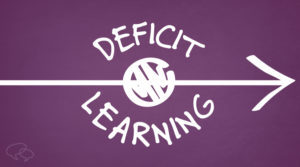
Do you remember the last time you had to change a flat tire? (Okay, maybe you just called AAA, but let’s just imagine you’re going to address this roadside crisis on your own).
Chances are, it’s been many years since you had to do this. As a result, when it happens, you’ll probably need to refresh your knowledge by dusting off the old owner’s manual or looking it up online.
And that’s okay. Why? Because let’s face it: you learn best when you’re in a deficit. You learn best when you need to learn something—not when knowing something might just help you, but when it absolutely will.
Salespeople are no exception. And, there’s a term I’ve developed for this baptism by fire approach to learning: I call it deficit learning. This is the learning approach that salespeople need when they have a skills gap or an acute performance need that they can’t afford not to address now.
After all, messaging and skills training that’s inflexible and event-based won’t be of much help when you need to respond to a challenge right away. Those challenges might include:
A troubled sales territory that’s up against a newly aggressive competitor
Weak pipeline or stalled deals that you’re on the brink of losing
An emergent threat to a dominant product or service that makes defending, retaining, and protecting your position paramount
A new product or go-to-market strategy launch, where you’re entering a new geography or trying to take some competitive share
Research shows these different situations call for dramatically different messaging, content, and skills training. One-size-fits-all messaging won’t cut it today. After all, it’s the buying situation and circumstances your buyers and their companies are facing—not their role or responsibility—that dictates their buying decisions. And that’s why “just-in-case” messaging and skills training—which reps may or may not need—will have limited impact. What they really need is just-in-time training that’s flexible, situational, and tailored to the key buying situations your prospects and customers are up against.
The technology to make just-in-time, situational learning a reality has been ready for a while. It’s the messaging, content, and skills—and the research to validate them—that have been lagging behind…until now.
In this webcast—Coaching the Just-in-Time, Situational Salesperson—I discuss what it takes to get salespeople the training they need, right when they need it. You’ll learn what it takes to get reps situationally ready and fluent to have the right conversation at the right moment—so you can be at your best no matter what selling challenge you face.
The post Deficit Learning, and The Rise of the Just-in-Time, Situational Salesperson appeared first on Corporate Visions.
Timothy Riesterer's Blog
- Timothy Riesterer's profile
- 3 followers




